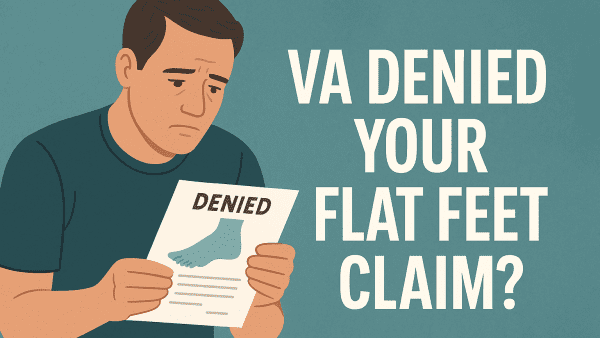Looking for Expert-Level VA Claim Answers?📱Call Us Now! 737-295-2226
When it comes to proving service connection for your VA disability claim, understanding the concept of continuity of symptomatology can be a game-changer for veterans.
If you’re a veteran struggling to prove your condition is connected to your military service, this legal principle could be the missing link to securing the VA disability benefits you deserve.
In this blog post, VA disability expert Brian Reese explains WHY continuity of symptomatology matters for your VA claim, WHAT it means for you, and HOW it works under 38 CFR 3.303(b).
He’ll also share tips, strategies, lessons learned, and examples to help you build a stronger case for VA disability benefits.
Let’s go!
Table of Contents
Summary of Key Points
- Definition and Legal Basis: Continuity of symptomatology allows veterans to establish service connection for a chronic condition under 38 CFR § 3.303(b) by proving symptoms began during service and continued after discharge. This method applies specifically to chronic diseases listed under 38 CFR § 3.309(a), such as arthritis, without requiring a formal diagnosis during service.
- Evidence Requirements: Veterans must demonstrate (#1) symptoms were noted during service or within the presumptive period, (#2) symptoms continued post-service without significant gaps, and (#3) the current disability matches the ongoing symptoms. Medical records, lay evidence, and personal statements play critical roles in filling documentation gaps.
- Proving Continuity of Symptoms Over Time with Examples: Examples like arthritis, back pain, and tinnitus show how veterans can successfully prove ongoing symptoms through medical records, post-service treatment, and lay evidence, even without an initial in-service diagnosis. These examples emphasize the importance of consistent medical history and symptom tracking.
- Pro Tips for Strengthening Your VA Claim: Veterans should gather service treatment records, secure post-service medical evidence, and leverage lay statements to demonstrate observable symptoms. While a Nexus Letter is not required, it can help you prove service connection by linking the condition to your military service.
Understanding Service Connection for VA Disability Benefits
To qualify for VA disability benefits, veterans must prove that their disability is service-connected—meaning it was “caused” or “aggravated” by their active duty military service or by another service-connected disability rated at 0% or higher for secondary service connection.
This requirement is outlined under 38 U.S.C.A. § 1110 and 38 C.F.R. § 3.303(a) and applies to all claims for VA disability compensation.
Three Key Elements to Prove Service Connection
According to case law (Hickson v. West, 1999 and Jandreau v. Nicholson, 2007), veterans must demonstrate the following:
- Current Disability: Evidence of a medically diagnosed condition that is currently impacting the veteran.
- In-Service Event, Injury, or Disease: Medical or lay evidence that the condition began during service, was caused by service, or was aggravated by service.
- Nexus (Link) Between the Condition and Service: Competent medical evidence that connects the current disability to the in-service event, injury, or disease.
These three elements also form The Caluza Triangle, which come from a U.S. Court of Appeals for Veterans Claims (Court) case called Caluza v. Brown, April 12, 1995, 7 Vet.App. 508 (1995).
Alternative Methods for Proving VA Service Connection
1. Chronicity
Under 38 C.F.R. § 3.303(b), veterans can prove service connection by showing chronicity if:
- A chronic disease (such as arthritis) was diagnosed during service, and
- The same condition continues to affect them after service.
If chronicity is established, no further evidence of continuity of symptoms is required.
2. Continuity of Symptomatology
When chronicity cannot be proven, veterans may rely on continuity of symptomatology to establish service connection.
This method applies to chronic diseases listed under 38 C.F.R. § 3.309(a) and requires veterans to demonstrate the following:
- The condition was noted during service.
- Post-service evidence shows continuity of symptoms related to the condition.
- Medical or lay evidence establishes a nexus between the current disability and the ongoing symptoms.
What is Continuity of Symptomatology for VA Disability?
Continuity of symptomatology refers to a legal concept used in VA disability claims to establish service connection for a condition that began during military service and has shown ongoing, chronic symptoms since discharge.
It requires evidence that the condition was noted in service, symptoms continued after service, and there is a link between the current disability and the in-service symptoms.
This approach is often used when a condition does not meet the criteria for direct service connection.
Instead of requiring a diagnosis in service, this approach allows veterans to show a continuation of symptoms from discharge to the present, linking their condition to military service.
Pro Tip: According to M21-1, continuous symptoms are demonstrated when the medical evidence shows symptoms continuing without stopping, or recurring regularly, with minimal interruptions, from military service.
How It Works for VA Disability Claims
To prove continuity of symptomatology, veterans must show the following:
- The condition was noted during service or during the presumptive period after service.
- Post-service medical evidence shows continuity of the same symptoms from service to the present.
- The current disability is a condition recognized as “chronic” under 38 CFR § 3.309(a) (e.g., arthritis).
Examples of Continuity of Symptomatology in Veterans
Example 1: Arthritis
A veteran experienced knee pain during service but was never formally diagnosed with arthritis. After discharge, the veteran continued to experience knee pain, sought treatment multiple times, and was later diagnosed with arthritis. By demonstrating ongoing symptoms through service treatment records, post-service medical visits, and lay statements, the veteran successfully established service connection.
Example 2: Back Pain
A veteran reported back pain after lifting heavy equipment during service. No formal diagnosis was made at the time, but post-service medical records documented repeated visits for back pain and an eventual diagnosis of degenerative disc disease. The continuity of symptoms from service through civilian life supported service connection.
Example 3: Hearing Loss and Tinnitus
A veteran was exposed to loud noise in service and complained of ringing in the ears. Years later, the veteran developed hearing loss and tinnitus. Even without a formal diagnosis in service, continuous complaints of hearing issues and post-service audiology records linked the condition to service.
Pro Tips for Proving Continuity of Symptomatology
1. Obtain Strong Medical Evidence:
- Collect service treatment records showing complaints or symptoms during service.
- Provide post-service medical records to document ongoing symptoms.
- Highlight gaps in treatment with explanations (e.g., lack of insurance).
2. Use Lay Evidence Effectively:
- Statements from family, friends, or coworkers can describe observable symptoms over time.
- These statements carry weight, especially when medical records are sparse.
- Your own personal statement in support of a claim also matters for explaining continuity of symptomatology over time.
3. Get a Nexus Letter from a Qualified Medical Provider:
- While not required for proving continuity of symptomatology, a Nexus Letter from a licensed physician (MD, DO, PA, NP) can help link your current disability to your active duty military service or another service connected disability for secondary service connection.
- The provider must use language like “at least as likely as not” to meet the VA’s 50/50 probability standard for service connection.
4. Highlight Severity of Symptoms Over Time:
- Demonstrate consistent severity of symptoms over time by showing regular treatments, medication use, or physical therapy.
- Explain any treatment gaps and how symptoms persisted despite the lack of care.
5. Reference VA Laws and BVA Decisions:
- Cite cases such as Savage v. Gober (1997) and Walker v. Shinseki (2013) to support VA claims based on continuity of symptoms.
- Highlight the VA’s requirement to grant claims when evidence is in equipoise under 38 U.S.C. § 5107(b).
Conclusion and Wrap-Up
Continuity of symptomatology is a powerful tool for veterans seeking VA disability benefits, especially when service records don’t show a formal diagnosis.
By demonstrating ongoing symptoms and building a strong case with medical evidence, lay statements, and expert opinions, you can meet the VA’s requirements under 38 CFR 3.303(b) and M21-1 guidelines.
Source List
Do You Need a Nexus Letter to Support Your VA Claim?
Are you looking to obtain a high-quality Nexus Letter to link your condition to your military service or to an existing service-connected disability for secondary service connection?
WE GOT YOUR SIX!
Veterans who become members of the VA Claims Insider Elite program can get access to our preferred provider network who can potentially write VA Nexus Letters at reduced rates.
Why pay $1,500 to $2,000 for a Nexus Letter when you can get one for 60-70% OFF what others might charge for the same service?
Click HERE to speak with an expert now (no-obligation, no high-pressure sales tactics).
Want Expert-Level Help with Your VA Disability Claim? WE GOT YOUR SIX!
How does VA Claims Insider help veterans?
We make the confusing and frustrating VA claim process EASY through our 8-step proprietary system and one-on-one coaching; we’re the VA Claim EXPERTS you can trust, and YOU are never alone in this fight against the VA!
You’ll also receive VA disability expert Brian Reese’s SEM Method Blueprint—a proven formula that has helped over 25,000 veterans win their VA disability claims faster:
Strategy + Education + Medical Evidence = VA Rating and Compensation You Deserve FASTER!
Start today and unlock an exceptional level of service you deserve for serving our country:
➡️ You’ll hear from a VA Claim Expert over email within 15 minutes of signing up today.
➡️ You’ll hear from your Veteran Coach team within 24 hours of all inquiries during normal business days/hours.
➡️ Our terms are clear and simple: If we don’t win, you don’t pay. You have nothing to lose and everything to gain.
Click the red button below to start the process of winning your VA claim right now!
Veterans: Are You Ready to WIN, SERVICE-CONNECT, and INCREASE Your VA Rating FASTER?

- VA Claims Insider is the #1 most trusted name in VA disability claims.
- Work directly with a VA claims coach who can help lead you to VA claim victory.
- 25,000+ disabled veterans served in our membership programs since 2016.
- 30% average rating increase for veterans who complete our #1 rated Elite program.
- 4.7/5.0 average rating out of 6,000+ total reviews; 5,000+ 5-star reviews.
About the Author

Brian Reese
Brian Reese is a world-renowned VA disability benefits expert and the #1 bestselling author of VA Claim Secrets and You Deserve It. Motivated by his own frustration with the VA claim process, Brian founded VA Claims Insider to help disabled veterans secure their VA disability compensation faster, regardless of their past struggles with the VA. Since 2013, he has positively impacted the lives of over 10 million military, veterans, and their families.
A former active-duty Air Force officer, Brian has extensive experience leading diverse teams in challenging international environments, including a combat tour in Afghanistan in 2011 supporting Operation ENDURING FREEDOM.
Brian is a Distinguished Graduate of Management from the United States Air Force Academy and earned his MBA from Oklahoma State University’s Spears School of Business, where he was a National Honor Scholar, ranking in the top 1% of his class.



